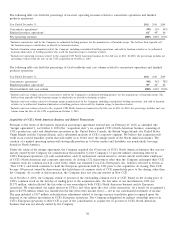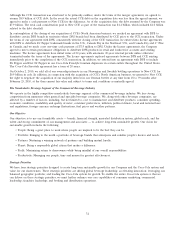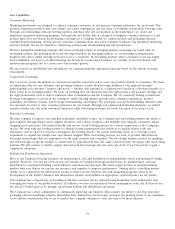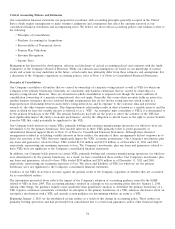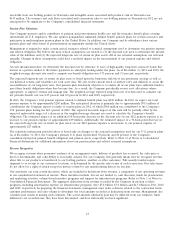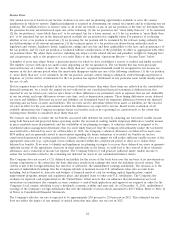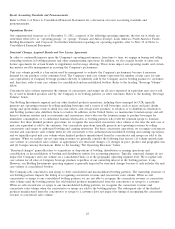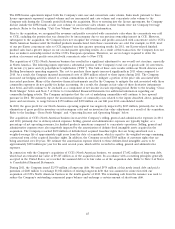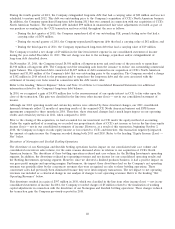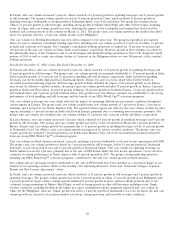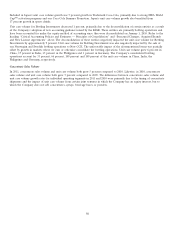Coca Cola 2011 Annual Report Download - page 42
Download and view the complete annual report
Please find page 42 of the 2011 Coca Cola annual report below. You can navigate through the pages in the report by either clicking on the pages listed below, or by using the keyword search tool below to find specific information within the annual report.specified territories. The franchise rights with definite lives relate to franchise rights that had previously provided CCE with
exclusive rights to manufacture and/or distribute certain beverages in specified territories for a finite period of time and, therefore,
have been classified as definite-lived intangible assets.
The Company recorded $8,050 million of goodwill in connection with this acquisition that was assigned to the North America
operating segment, of which $170 million is tax deductible. This goodwill is primarily related to synergistic value created from
having a unified operating system that will strategically position us to better market and distribute our nonalcoholic beverage
brands in North America. It also includes certain other intangible assets that do not qualify for separate recognition, such as an
assembled workforce.
In 2009, the Company recognized a $23 million impairment charge due to a change in the expected useful life of an intangible
asset, which was previously determined to have an indefinite life. Refer to the heading ‘‘Operations Review — Other Operating
Charges’’ below and Note 16 and Note 17 of Notes to Consolidated Financial Statements.
Hyperinflationary Economies
Our Company conducts business in more than 200 countries, some of which have been deemed to be hyperinflationary economies
due to excessively high inflation rates in recent years. These economies create financial exposure to the Company. Venezuela was
deemed to be a hyperinflationary economy subsequent to December 31, 2009.
As of December 31, 2009, two main exchange rate mechanisms existed in Venezuela. The first exchange rate mechanism is known
as the official rate of exchange (‘‘official rate’’), which is set by the Venezuelan government. In order to utilize the official rate,
entities must seek approval from the government-operated Foreign Exchange Administration Board (‘‘CADIVI’’). As of
December 31, 2009, the official rate set by the Venezuelan government was 2.15 bolivars per U.S. dollar. The second exchange
rate mechanism was known as the parallel rate, which in some circumstances provided entities with a more liquid exchange
through the use of a series of transactions via a broker.
Subsequent to December 31, 2009, Venezuela was determined to be a hyperinflationary economy, and the Venezuelan government
devalued the bolivar by resetting the official rate to 2.6 bolivars per U.S. dollar for essential goods and 4.3 bolivars per U.S. dollar
for nonessential goods. In accordance with hyperinflationary accounting under accounting principles generally accepted in the
United States, our local subsidiary was required to use the U.S. dollar as its functional currency. As a result, we remeasured the
net assets of our Venezuelan subsidiary using the official rate for nonessential goods of 4.3 bolivars per U.S. dollar. During the
first quarter of 2010, we recorded a loss of $103 million related to the remeasurement of our Venezuelan subsidiary’s net assets.
The loss was recorded in the line item other income (loss) — net in our consolidated statement of income. We classified the
impact of the remeasurement loss in the line item effect of exchange rate changes on cash and cash equivalents in our
consolidated statement of cash flows.
In early June 2010, the Venezuelan government introduced a newly regulated foreign currency exchange system known as the
Transaction System for Foreign Currency Denominated Securities (‘‘SITME’’). This new system, which is subject to annual limits,
replaced the parallel market whereby entities domiciled in Venezuela are able to exchange their bolivars to U.S. dollars through
authorized financial institutions (commercial banks, savings and lending institutions, etc.).
In December 2010, the Venezuelan government announced that it was eliminating the official rate of 2.6 bolivars per U.S. dollar
for essential goods. As a result, there are currently only two exchange rates available for remeasuring bolivar-denominated
transactions, the official rate of 4.3 bolivars per U.S. dollar for nonessential goods and the SITME rate. As discussed above, the
Company has remeasured the net assets of our Venezuelan subsidiary using the official rate for nonessential goods of 4.3 bolivars
per U.S. dollar since January 1, 2010. Therefore, the elimination of the official rate for essential goods had no impact on the
remeasurement of the net assets of our Venezuelan subsidiary. We continue to use the official exchange rate for nonessential
goods to remeasure the financial statements of our Venezuelan subsidiary. If the official exchange rate devalues further, it would
result in our Company recognizing additional foreign currency exchange losses in our consolidated financial statements. As of
December 31, 2011, our Venezuelan subsidiary held monetary assets of $300 million.
In addition to the foreign currency exchange exposure related to our Venezuelan subsidiary’s net assets, we also sell concentrate
to our bottling partner in Venezuela from outside the country. These sales are denominated in U.S. dollars. Some of our
concentrate sales were approved by the CADIVI to receive the official rate for essential goods of 2.6 bolivars per U.S. dollar
prior to the elimination of the official rate for essential goods in December 2010. Prior to the elimination of the official rate for
essential goods, our bottling partner in Venezuela was able to convert bolivars to U.S. dollars to settle our receivables related to
sales approved by the CADIVI. However, if we are unable to utilize a government-approved exchange rate mechanism to settle
future concentrate sales to our bottling partner in Venezuela, the Company’s outstanding receivables balance related to these
sales will continue to increase. In addition, we have certain intangible assets associated with products sold in Venezuela. If we
are unable to utilize a government-approved exchange rate mechanism for concentrate sales, or if the bolivar further devalues,
it could result in the impairment of these intangible assets. As of December 31, 2011, the carrying value of our accounts
40


